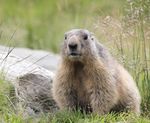Another Successful Living in the Natural Environment!
←
→
Page content transcription
If your browser does not render page correctly, please read the page content below
From Barnyard to Backyard
Topics of Interest from the MD Agricultural & Environmental Services Department
Another Successful Spring 2020
Living in the Natural Environment!
The annual Living in the Natural Environment event took place
on February 7, 2020 at the RancheHouse in Cochrane. With the
evening consisting of numerous tradeshow displays, dinner,
and two thought provoking and well delivered presentations.
The first, from Dr. David Andison from fRI Research speaking
on the complexity, changes, and challenges of fire ecology in
Alberta. The second, presented by Dr. Geoff Holroyd from the
Beaverhill Bird Observatory was a case study of tree swallows
in Central Alberta and how the change in their numbers may
be indicating changes to our ecosystems and environment.
With approximately 120 people in attendance, the evening was
filled with good company, engaging conversation, and of course
intriguing presentations. Also, a pleasant surprise for those in
attendance - Hawkeye, a rehabilitated Northern Hawk Owl from
the BirdSmart program Dr. Holroyd had with him. It was a great
opportunity for people to learn about the species and get up close
and personal with a spectacular bird.
Thank you to all those who attended, the speakers, everyone that worked hard to
organize it, and to all the sponsors for making Living in the Natural Environment possible.
What’s Inside
Living in the Natural Environment.................................. 1 Advancing Women in Agriculture.................................... 3
Chinese Mystery Snail.....................................................2 Invasive Weed Control......................................................4
Why Soil is Important...................................................... 3 Co-existing with Wildlife................................................... 5
Moving Firewood............................................................. 3 Upcoming Events............................................................. 6
Page 1Chinese Mystery Snail in Alberta:
A Very Spe-shell Case
By Paige Kuczmarski, Alberta Environment and Parks
Although this isn’t our regular snail’s pitch of stopping the spread
of aquatic invasive species (AIS) with “Clean, Drain, Dry” or “Don’t
let it Loose”, we still need your undivided attention! We were
shell-shocked to find our first location of the invasive Chinese
mystery snail (Cipangopaludina chinensis) in Alberta this year in
McGregor Lake! This species is one of 52 prohibited species listed
on the Fisheries (Alberta) Act, meaning we must fight tooth and
snail to slow this species from spreading. We need you to come
out of your shell and help us with ANY information, such as dates,
photos or locations of Chinese mystery snail you may have seen
in the past few years. A photo was shared with us showing two
people holding up the large snail shells, which gives us reason to
believe it has been here since 2016.
This snail is very noticeable with a large, globular shell that can reach sizes of 6 cm. Distinct sutures and fine
growth lines on the brown to olive colored shell also help with identification. Chinese mystery snail can be
found buried in soft muddy or sandy substrates in freshwater lakes, streams and rivers. This species of snail
can tolerate less than ideal conditions and survive out of water for up to 4 weeks due to the protection provided
by an operculum or ‘trap-door’ – this alone warrants concern for further spread through transportation of
watercrafts or gear.
In a nutshell, Chinese mystery snail is named after its mysterious
reproductive abilities of giving birth to fully developed juvenile snails,
which can happen as many as 169 times per year! This species
can impact the growth and abundance of native snail species by
competing for habitat and resources, as well as effect water intake
pipes and other submerged equipment as their large shells can
clog and stop water flow. Furthermore, Chinese mystery snail are
considered edible and often sold in Chinese food markets despite it
being an intermediate host to multiple parasites that could impact
human health. Basically, its ability to rapidly reproduce, tolerate
unfavorable conditions and out-compete native species shows that
Chinese mystery snails have all the characteristics that make a
species highly invasive – any details you may have would help us
before this population spirals out of control!
Always remember:
• To avoid snail mail! Always report aquatic • Take it slow! Always Clean, Drain, Dry your gear
invasive species through EDDMapS Alberta before moving between waterbodies.
or directly through email, ais@gov.ab.ca or by • If it’s a mystery to you, learn to identify Alberta’s
phone, 1-855-336-BOAT (2628). 52 prohibited aquatic invasive species using our
• Don’t be shell-fish! Don’t let it loose – never pocket guide. (can be found at:
release live animals, plants or aquarium water https://open.alberta.ca/publications)
into the environment.
Page 2MOVING FIREWOOD
can transport forest
insects and diseases.
If you’re a camper heading out for
a trip — or just getting firewood for
your stove — do nature a favor. Don’t
potentially transport invasive species.
Buy locally harvested firewood.
Gather on site where permitted.
Ask a park ranger or campground
host about where to get local firewood.
The forest will thank you.
DON’T PICK UP
STRANGERS.
Help Prevent The Spread
Of Invasive Plants And Animals.
• REMOVE plants, animals & mud from boots, gear, pets &
vehicle.
• CLEAN your gear before entering & leaving the recreation
site.
• STAY on designated roads & trails.
• USE CERTIFIED or local firewood & hay.
Page 3Invasive Weed Control Program
The M.D. of Bighorn’s Agricultural and Environmental Services staff will be
carrying out their invasive weed control program from
June 1st to September 30th throughout the entire municipality.
In accordance with the Weed Control Act, on land you own or occupy, it
is your responsibility to:
1. Control Noxious Weeds
2. Destroy Prohibited Noxious Weeds
To learn more, the Weed Control Act and Weed Control Regulation can be found at:
www.agriculture.alberta.ca.
For more information or to report a suspected regulated weed, please contact the M.D. of Bighorn’s
Agricultural and Environmental department at: 403-673-3611
Please be cautious when passing roadside spray staff.
- Weed Watch -
Creeping Bellflower (Campanula rapunculoides)
Designated as Noxious under the Weed Control Act
Description
• During the spring it grows low to the ground
• Mature plants grow up to 1 m
• Leaves are heart-shaped in early stages
of growth then become lance-shaped with
toothed margins.
• Flowers are bell-shaped, nodding and range
Photo Credit: Nicole Kimmel from purple to blue in color
Control Methods
• Cutting, hand pulling and
At a Glance
digging up the plant are Very tenacious, spreads
the most effective control broadly, whitish underground
options. rhizomes, and thick tubers
• Care must be taken as it can Numerous irregular toothed
re-sprout from its creeping heart-shaped leaves
root system.
• Control will take several Blue or purple bell-shaped
seasons to attain. flowers
Photo Credit: Alberta Invasive Species Council
Page 4Wildlife in the M.D.
As anyone living in the M.D. of Bighorn can tell you,
encountering wildlife is nearly a daily experience.
Whether it’s passing a heard of bighorn sheep on the
highway, bears taking a shortcut through you yard, or
one of the many species of songbird greeting you with
a song in the morning, it is a truly wonderful place to
call home. However, with these advantages comes
a responsibility to co-exist by minimizing potential
conflicts.
What Can I Do?
• Plant wildlife friendly species in your yard (non-
fruiting species)
• Maintain a safe distance from wildlife
• Keep dogs leashed when hiking
• Obey trail closures and warnings
• Carry bear spray
• Staying on designated paths
• Do not feed or allow wildlife access to human
food (i.e. garbage, food scraps, unattended
coolers, etc.)
For additional information please visit:
• The Agriculture and Environment section on the MD of Bighorn’s website:
www.mdbighorn.ca/226/Agriculture-Environment
• WildSmart: www.biosphereinstitute.org/wildsmart
• Government of Alberta: www.alberta.ca/living-with-wildlife.aspx
Page 5Mark Your Calendar for these Upcoming
Events.....
Agricultural Services and
Advancing Women in Agriculture Conference
Environmental Advisory March 23 & 24
Board (ASEAB) Hyatt Regency, Calgary
For women passionate about agriculture and food. From
Council Appointments: university or college students studying agriculture,
producers, ranchers, entrepreneurs, representatives of a
Erik Butters - Ward 4
grower association or corporate agribusiness. This event
Paul Clark (Deputy Reeve) - Ward 3
offers opportunities to enhance their family life, community,
career, and industry.
Farmer Representatives:
For registration information please visit:
Jackie Gemmill (Chair) www.advancingwomenconference.ca
Patricia Macmillan
Dwight Tannas
Bryne Weerstra
Alberta Agriculture Key Contact:
Sandy Stafford
Agricultural Services Staff
Kendra Tippe
Environmental Fieldman
403-673-3611 Ext. 234
kendra.tippe@mdbighorn.ca
Andrew Richmond
Assistant Environmental Fieldman
403-673-3611 Ext. 241
andrew.richmond@mdbighorn.ca
www.mdbighorn.ca
Page 6You can also read



























































